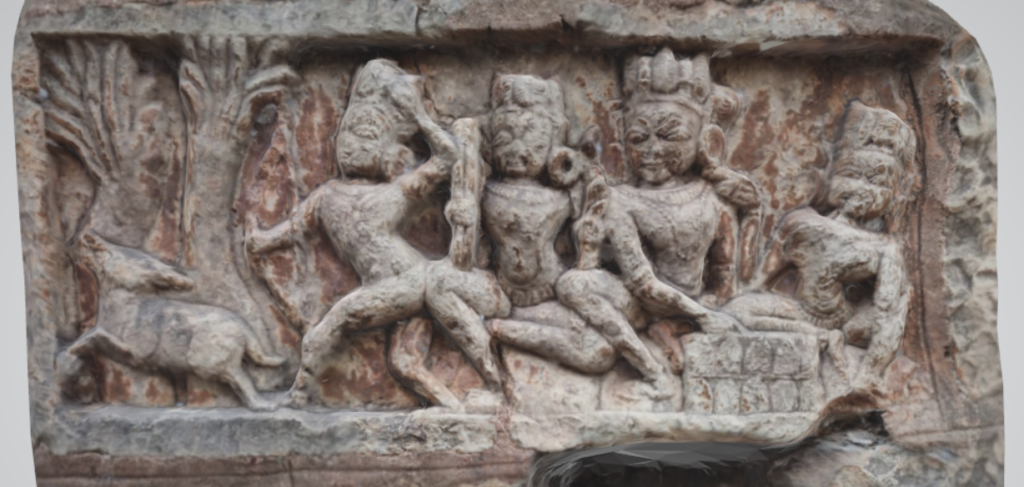The Vishnu Temple of Janjgir-Champa district, Chhattisgarh is located on the banks of a pond named Bhima Talab. The temple is constructed based on Sapta-Ratha plan which has seven projections. It is built over a 10 feet high platform. The temple construction was started in two parts. However, it was never completed. The shikhara of the temple has been left unfinished.

It is a protected monument in Chhattisgarh proclaimed by the Archaeological Survey of India. According to historical reports, Janjgir was previously known by the name Jajallapura. Inscriptions reveal that Kalchuri King Jajalladeva-I established Jajallapura. Therefore, the Vishnu temple can be assigned to Kalchuri King Jajalladeva-I.
Presently, the garbhagriha and antarala part of the temple exists. The temple had a mandapa which has not survived. The adhishthana consists of six mouldings. There are murals of elephants and Simha-vyalas with riders are engraved on the adhishthana. The mandovara is divided into two rows. The baranda between the mandovara and shikhara has four mouldings. The shikhara was built up to six stories and then left incomplete.

The main doorway of the temple is beautifully carved. The door jambs have three large images of river goddesses, Ganga and Yamuna escorted by dvarapalas. The carving of Lord Vishnu riding over Garuda is present above the lintel. Lord Vishnu with Lord Brahma and Lord Shiva are found at the two terminals just above the door. The intervening space between Lord Vishnu, Lord Brahma, and Lord Shiva is filled with depictions of navagrahas. The temple comprises of four steps, then an Antarala, the magnificent doorframe and door then garbhagriha. The shape of inner sanctum is square which measured around 3.9 meter in every side and the outside measured 7.7 meter. The adjacent Antarala to garbhagriha measured near about 2.15 meter x 1.2 meter and just beside it the presence of dwarf pillars gives the idea of main Mandapa which may be there in plant but somehow could not executed.
The platform has many carvings embedded. There are small panels engraved on the panel that depict events from Ramayana.

There is a sculpture depicting the Ram Ravan Yudh. The Yuddh Kanda from Ramayan describes this battle between Lord Ram and Ravan. When Sri Hanuman brought information about Devi Sita, Lord Ram, and Lakshman proceeded with the Vanaras toward the southern sea. There Ravan’s brother Vibhishan joins them. The Vanaras constructed a floating bridge (known as Ram Setu) across the sea. This helped Lord Ram and Lakshman along with the Vanarahs to cross over to Lanka. A lengthy battle takes place, where Lord Ram kills Rávaṇ. Lord Ram then installs Vibhishana on the throne of Lanka and brings back his wife Devi Sita.

A sculpture of Lord Ram piercing the shal trees is engraved on a panel. This event is when Lord Ram encounters the Vanara kingdom during his forest exile. Despite Lord Ram’s assurance, Sugriva, the king of Vanaras, wanted to examine Lord Ram’s strength to determine if he could kill Bali, the elder brother of Sugriva and rival for the Varana throne. Sugriva narrated to Ram a story that revealed Bali’s strength. Sugriva showed Lord Rama the carcass of a demon named Dundhubhi who was killed by Bali and pointed out at the same time towards seven shal trees. He said that Bali pierced each of them in a single stroke and questioned him whether he could accomplish such achievements. On being confronted, Lord Rama threw away the carcass of Dundhubhi with a single stroke and immediately struck all seven trees with a single arrow.

The temple has carvings of many deities. There are carvings of Lord Narasimha and Lord Vishnu in the upper and lower niche respectively. On the southern wall, there are images of Goddess Parvati, Lord Agni, Lord Brahma, Lord Ishan, and Goddess Vaishnavi. The wall on the west has Lord Vishnu and Lord Surya with his seven-horse chariot. Among the other images on the west wall are Goddess Sarasvati, Lord Shiva, Lord Yama, Lord Ishan, and Lord Indra. The wall on the north has carvings of Lord Vishnu, Lord Brahma, Lord Varuna, Lord Shiva, Lord Ishan, and Lord Vayu. The niches on the antarala space have carvings of Lord Varaha and Lord Vishnu.

A sculpture depicting Sita Haran from the Aranya Kand of Ramayan can be found in this Vishnu temple. During the exile, Lord Ram, Devi Sita, and Lakshmana at the Panchavati forest were visited by Shurpanakha, who is the sister of Ravana. Lakshmana cuts off Shurpanakha’s nose when she attempts to kill Devi Sita. Ravana resolves to destroy Lord Ram by capturing his wife, Devi Sita with the help of the Maricha who disguises himself in the form of a golden deer. Lord Ram chases the golden deer into the forest, leaving Devi Sita under Lakshman’s protection. After some time, Devi Sita hears Lord Ram calling out to her; she insists that Lakshman rushes to his aid. As Lakshman leaves the cottage, Ravan appears as an ascetic requesting Sita’s hospitality. Unaware of Ravana’s plan, Sita is tricked and is then forcibly carried away by Ravana.

There is another panel that shows Pandavas worshipping a Shiva lingam. This panel has only three Pandava brothers. A similar panel is found in Gandai, Deorbija, and Ratanpur, in which all the Pandava brothers, sometimes even accompanied by Kunti and Draupadi are shown worshipping Shiva lingam.

